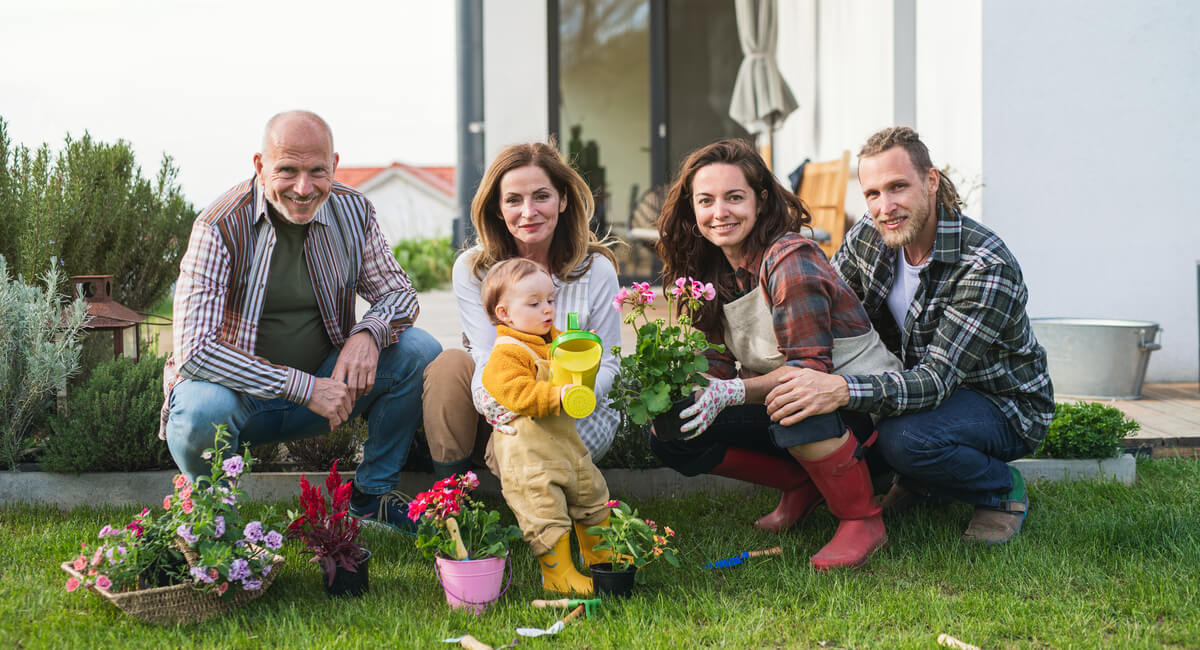A multigenerational household may not be the most common living arrangement in the United States, but it’s becoming more and more popular. More Americans live in multigenerational homes now than they did a few decades ago, and the numbers seem to be steadily increasing.
A multigenerational household is usually defined as a household that includes two or more adult generations. Multigenerational households often include children as well. The most common form of multigenerational living is a working-age adult or couple, their children, and their aging parents. Multigenerational homes can take on many other forms, too.

Benefits Of Multigenerational Living
Living with multiple generations of family isn’t the right choice for everyone, but it does offer several advantages. When the family dynamics are healthy and supportive, a multigenerational home can benefit everyone financially, functionally, and emotionally. Here are six key benefits of living in a multigenerational household:
Shared Expenses
Finances are one of the biggest reasons more Americans are choosing to live in multigenerational homes. Housing costs and living expenses have risen dramatically in recent years, and many younger individuals and couples are struggling to afford homes on their own.
When multiple generations of adults live together, everyone can pool their financial resources. Splitting the mortgage, utilities, and home improvement expenses can greatly ease the burden on each family member. The older generation can live comfortably in their retirement while keeping their expenses low, and the working-age adults can save for their own retirement. Additionally, parents can save more for their children’s future, setting the next generation up for success.
Shared Responsibilities
Just like you can split the bills in a multigenerational household, you can also split the household tasks. Chores like laundry, cooking, and washing dishes will require more time and effort when the household is larger. However, if your household divides up these responsibilities, each person will likely spend less time on each task than they would if they lived in a smaller household.
In a larger household, each family member can also take on the tasks that they’re best at. One person may enjoy cooking and can make the majority of the family’s meals, and another may offer to handle yard work. This can be especially helpful for aging adults who might be unable to manage physically demanding tasks.
Safety
Home security is an important but often overlooked benefit of multigenerational living. When larger families live together, at least one person will probably be home most of the time. This can deter burglars and ensure that someone will respond right away in the event of a fire, maintenance emergency, or other serious issue.

Support for Aging Family Members
Caring for elderly parents is one of the most common concerns for middle-aged adults. Some seniors try to age at home while living alone, but this can create major health and safety risks. Retirement communities and skilled nursing homes offer professional care, but they can also be extremely expensive. Multigenerational living offers a solution to these challenges.
Older adults find it far easier to age in place when they live with their adult children. When you already have a multigenerational household, you don’t have to figure out the logistics of moving your parents into your house or arranging for their care. They’re already set up in a safe and supportive living arrangement. You might have to make some modifications to the house as they get older, but this can be much less stressful than moving them into an entirely new home.

Childcare Assistance
The cost of childcare is a massive obstacle for many families. In some cases, it’s cheaper for one parent to leave their job and stay home with the kids than it is to pay for daycare. Some parents also feel uncomfortable with their children being cared for by someone who isn’t a close family member or friend.
Multigenerational living can be a great solution to the childcare issue. If one or both grandparents are retired, they may be able to care for the children while the parents are at work. Many grandparents love spending time with their grandchildren and are happy to watch the kids at any time. This can help working-age adults save tens of thousands of dollars in childcare costs.
Stronger Family Relationships
Living in a multigenerational household can strengthen the bond between family members. Everyone leans on each other for support, which helps to build trust and connection. Grandparents can be present as their grandchildren grow up, and middle-aged adults can spend quality time with their parents as they age. If you and your family have healthy communication and respect for one another, a multigenerational living arrangement can help you feel less lonely and more secure in your relationships.

Tips For Living In A Multigenerational Household
Multigenerational living offers so many benefits, but it also has its challenges. For instance, if one family member feels like they’re being taken advantage of, the arrangement can quickly turn sour. Spending too much time together without privacy can cause bickering and frustration, too. To have a successful multigenerational household, you have to make sure that everyone’s needs are being met. Here are three tips for maintaining a happy and healthy multigenerational home:
Create Separate Spaces
One of the advantages of multigenerational living is that families can spend time together, but it’s also important for everyone to have their own space. Ideally, a multigenerational home should have enough space that each generation feels like they can get away when they need privacy. In-law apartments and finished basements are great for multigenerational households. It can also be helpful for each generation to have their own kitchenette as sharing food and kitchen space can sometimes create tension.
Communicate Openly
Communication is the most vital skill families need in order to successfully live in a multigenerational home. It’s important that everyone agrees to a fair division of responsibilities and that everyone feels comfortable speaking up when something is bothering them. You could even create a written contract or list of house rules so that each family member’s boundaries are understood and respected.

Focus on Quality Time
You spend a lot of time with your family when living in a multigenerational household, but you should also make sure that you have meaningful quality time together. You could have weekly movie or game nights with the whole household, or you could plan recurring family outings. Eating dinner together can be a great way to enjoy each other’s company, too. Quality time will strengthen your relationships, encourage healthy communication, and allow you to fully reap the benefits of multigenerational living.
A multigenerational household may not be the perfect arrangement for all families, but it can be a great living situation when approached in the right way. Not only is a multigenerational home financially savvy, but it allows every generation to receive the care and support they need. When you and your family have a culture of trust and respect, multigenerational living can offer powerful benefits.


